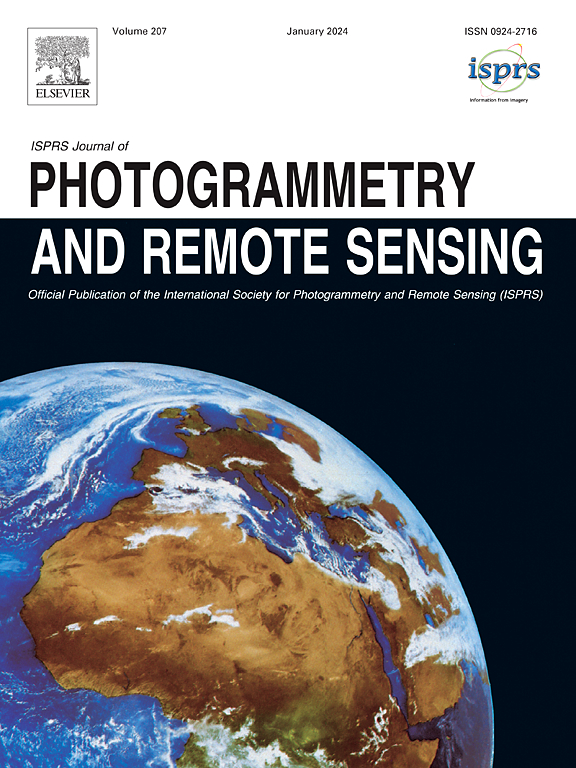Bundle adjustment for multi-source Mars orbiter imagery with generalized control constraints
IF 10.6
1区 地球科学
Q1 GEOGRAPHY, PHYSICAL
ISPRS Journal of Photogrammetry and Remote Sensing
Pub Date : 2025-06-24
DOI:10.1016/j.isprsjprs.2025.05.030
引用次数: 0
Abstract
Integration of multi-source Mars orbiter imagery leverages diverse datasets to enhance surface details and mapping accuracy. Achieving spatial consistency is crucial, yet challenges arise from significant resolution differences and the lack of ground control points. This paper proposes a bundle adjustment method with generalized control constraints tailored for multi-source orbiter imagery. A bias compensation model using affine and cubic spline functions is employed to effectively correct linear and nonlinear distortions. Generalized control constraints integrate planar and elevation aspects through planar control points, virtual control points, tie points, and terrain information. Planar weak control constraints are established by crater features extraction utilizing the Segment Anything Model 2, ellipse fitting, and accurate point set matching, with further enhancement from slope information derived from reference terrain. Elevation control constraints are established using the reference Digital Elevation Models and slope data. An adaptive weighting strategy is developed to combine these aspects optimally, facilitating precise registration of multi-source orbiter imagery to a unified Mars reference frame. Experiments with Mars Context Camera (CTX) and High-Resolution Imaging Science Experiment data validate the performance of the proposed method across various Martian terrains, demonstrating significant reductions in reprojection residuals from approximately 10 pixels to under 0.8 pixels. Additionally, the planar positioning accuracy improved from a maximum of over 300 m to within 18 m, with elevation accuracy within 3 m. Comparisons with existing adjustment methods and fully controlled CTX mosaic products confirm the effectiveness and reliability of the proposed method.
广义控制约束下多源火星轨道图像的束平差
多源火星轨道图像的集成利用了不同的数据集来提高表面细节和制图精度。实现空间一致性至关重要,但巨大的分辨率差异和缺乏地面控制点带来了挑战。针对多源轨道图像,提出了一种具有广义控制约束的束平差方法。基于仿射和三次样条函数的偏置补偿模型可以有效地校正线性和非线性畸变。广义控制约束通过平面控制点、虚拟控制点、结合点和地形信息整合平面和高程方面。利用分段任意模型2提取陨石坑特征、椭圆拟合和精确点集匹配建立平面弱控制约束,并利用参考地形的坡度信息进一步增强控制约束。利用参考数字高程模型和坡度数据建立高程控制约束。开发了一种自适应加权策略,以最佳地结合这些方面,促进多源轨道飞行器图像到统一的火星参考框架的精确配准。利用火星环境相机(CTX)和高分辨率成像科学实验数据进行的实验验证了该方法在各种火星地形上的性能,结果表明,重投影残差从大约10像素显著降低到0.8像素以下。平面定位精度从最高300 m以上提高到18 m以内,高程精度提高到3 m以内。通过与现有平差方法和全可控CTX拼接产品的对比,验证了所提方法的有效性和可靠性。
本文章由计算机程序翻译,如有差异,请以英文原文为准。
求助全文
约1分钟内获得全文
求助全文
来源期刊

ISPRS Journal of Photogrammetry and Remote Sensing
工程技术-成像科学与照相技术
CiteScore
21.00
自引率
6.30%
发文量
273
审稿时长
40 days
期刊介绍:
The ISPRS Journal of Photogrammetry and Remote Sensing (P&RS) serves as the official journal of the International Society for Photogrammetry and Remote Sensing (ISPRS). It acts as a platform for scientists and professionals worldwide who are involved in various disciplines that utilize photogrammetry, remote sensing, spatial information systems, computer vision, and related fields. The journal aims to facilitate communication and dissemination of advancements in these disciplines, while also acting as a comprehensive source of reference and archive.
P&RS endeavors to publish high-quality, peer-reviewed research papers that are preferably original and have not been published before. These papers can cover scientific/research, technological development, or application/practical aspects. Additionally, the journal welcomes papers that are based on presentations from ISPRS meetings, as long as they are considered significant contributions to the aforementioned fields.
In particular, P&RS encourages the submission of papers that are of broad scientific interest, showcase innovative applications (especially in emerging fields), have an interdisciplinary focus, discuss topics that have received limited attention in P&RS or related journals, or explore new directions in scientific or professional realms. It is preferred that theoretical papers include practical applications, while papers focusing on systems and applications should include a theoretical background.
 求助内容:
求助内容: 应助结果提醒方式:
应助结果提醒方式:


